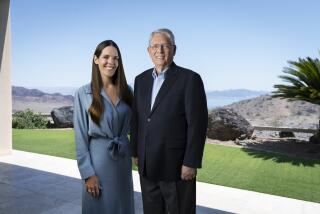Internet Cancer Site Offers Patients Research and Reassurance
- Share via
When Jason Sprenkle, a 28-year-old attorney in Columbia, S.C., thought his mother might have breast cancer, he did the first thing any good son might do: He went to the Internet for more information.
Two mammograms had identified a suspicious mass in Linda Sprenkle’s right breast, and now the 51-year-old Guilford, Conn., woman was facing a biopsy to rule out cancer. Jason found 15 relevant Internet articles about biopsy methods and treatments for the disease, and his mother was reassured.
“I felt this wasn’t a death sentence because of everything they were able to provide me with,” she explains. Sprenkle’s surgeon even helped compile questions for Jason to look up on the Net.
“It put her at ease since she wasn’t at a loss for information and she could take more control of the situation,” says Jason.
His primary source was OncoLink (https://oncolink.upenn.edu/), maintained by the University of Pennsylvania’s Cancer Center. Founded by physicist Loren Buhle and oncologist Dr. Joel Goldwein in 1994, OncoLink has become the Internet’s premier cancer site. It features more than 6,000 documents, most of them reviewed by experts in the field.
OncoLink draws much of its material from huge databases of cancer information compiled by both the National Cancer Institute and the American Cancer Society. Visitors can search for information both by disease category (brain cancer, breast cancer, leukemia) or by medical specialty.
The site also offers the latest on new research studies (clinical trials), cancer pain management, and helping families cope with the emotional and financial burdens brought on by the disease.
Breast cancer patients, for example, can read NCI documents in easy-to-understand language. They can also read huge documents prepared for health professionals that cover every aspect of cancer, including diagnosis, staging and treatment.
“The empowerment of patients is where OncoLink’s getting its most utility,” says Dr. Ivor Benjamin, co-editor in chief and a gynecological oncologist at the University of Pennsylvania. “Patients grappling with a new cancer diagnosis or a change in management have a thirst for knowledge. These patients are turning to the Internet in record numbers.”
With more than a million hits monthly, OncoLink has provided information to users in at least 75 countries.
For Jason Sprenkle, the Internet provided a way to bridge the several hundred miles between him and his mother.
“You feel helpless in your ability to help the person dealing with cancer,” he says. “One of the only ways I could help her from out of town was to give her as much information as I could.”
Fortunately for the Sprenkles, Linda’s biopsy was negative.
Ironically, three weeks after I started research for this story, my mother underwent a biopsy to rule out cancer in a suspicious lump in her breast. The biopsy revealed “cancer in situ,” an early stage.
After hearing the diagnosis, I consulted OncoLink’s NCI documents on breast cancer. The reports provided reassurance to me, my mother and my family that survival from “cancer in situ” is very high with proper treatment, in her case simply a lumpectomy.
As with Jason Sprenkle, OncoLink empowered me by providing the latest information and helping my mother and family negotiate the difficult period both before and after diagnosis.
Dr. Tom Linden is coauthor of “Dr. Tom Linden’s Guide to Online Medicine,” published by McGraw-Hill. He welcomes comments at [email protected]




